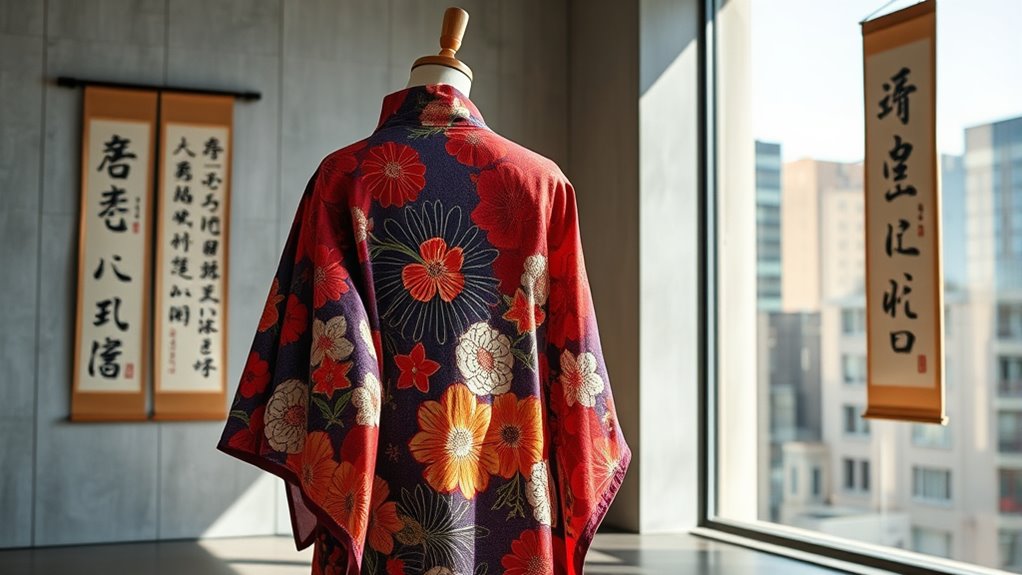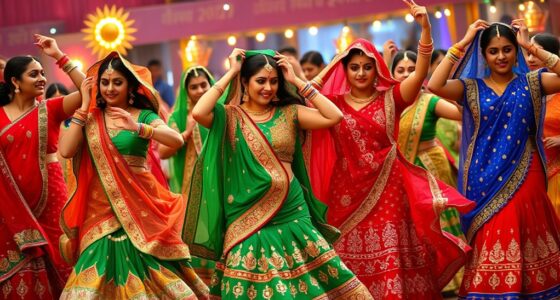The kimono’s cultural significance in contemporary style shows how tradition seamlessly blends with modern fashion. You’ll see it symbolizing respect, elegance, and continuity while adapting through lighter fabrics, simplified cuts, and Western influences. It’s now worn beyond ceremonies, inspiring global designers and everyday wear. This evolving garment represents Japan’s rich history and innovative spirit. If you keep exploring, you’ll discover how the kimono continues to shape cultural identity today.
Key Takeaways
- The kimono remains a symbol of Japanese cultural identity, blending tradition with modern fashion trends.
- Contemporary styles incorporate simplified cuts and lighter fabrics, making kimono more accessible for daily wear.
- Wearing kimono during festivals and ceremonies emphasizes respect, tradition, and cultural continuity.
- Modern adaptations serve as a bridge connecting Japan’s historical heritage with evolving societal identities.
- Kimono-inspired designs inspire global fashion, showcasing Japan’s cultural richness in contemporary style.

Have you ever wondered why the kimono remains a powerful symbol of Japanese culture? Its enduring presence reflects deep-rooted kimono symbolism that connects past and present, tradition and innovation. The kimono isn’t just clothing; it embodies centuries of history, social values, and artistry. Every color, pattern, and fold tells a story, often representing seasons, occasions, or even personal status. When you see someone wearing a kimono, you’re witnessing a visual language that communicates respect for tradition while also embracing modern expressions of style.
In contemporary Japan, modern kimono adaptations have gained popularity, blending traditional craftsmanship with current fashion trends. Designers are reimagining the garment, creating styles that are more accessible for daily wear or special events. These adaptations often feature simplified cuts, lighter fabrics, and updated patterns, making the kimono more practical without sacrificing its cultural essence. You might notice that some modern kimonos incorporate Western influences, such as shorter lengths or hybrid designs, which makes them appealing to younger generations seeking to honor their heritage while also expressing individuality. These innovations demonstrate how the kimono’s symbolism evolves, reflecting the dynamic nature of Japanese identity.
Yet, even with these modern adaptations, the core significance remains intact. The kimono continues to symbolize respect, elegance, and a connection to Japanese traditions. When you see someone donning a kimono today, it’s often during cultural festivals, ceremonies, or special occasions like weddings and tea ceremonies. In these moments, the garment’s symbolism is amplified, emphasizing continuity amid change. It’s a reminder that while styles may shift, the cultural values embedded in the kimono endure, serving as a bridge between generations.
The fusion of traditional and contemporary styles also underscores the kimono’s versatility. It’s not confined to museums or historical reenactments; it actively lives in modern society, inspiring fashion designers and enthusiasts alike. You may even find boutique brands producing contemporary kimono-inspired pieces that blend Japanese motifs with global fashion trends. This ongoing adaptation affirms that the kimono remains relevant, not only as a symbol of Japan’s rich history but also as a vibrant, evolving expression of its culture. Additionally, advances in modern textile technology have enabled the production of lighter, more comfortable fabrics that make kimono-inspired fashion more practical for everyday wear. Whether worn in its classic form or its modern iterations, the kimono continues to tell stories—stories woven into fabric that connect the country’s past to its future.
Frequently Asked Questions
How Has the Kimono Influenced Global Fashion Trends?
The kimono influences global fashion trends by inspiring designers to incorporate its symbolism, such as intricate patterns and flowing silhouettes, into modern garments. You’ll notice its impact in the use of sash belts, layered fabrics, and elegant lines that evoke traditional aesthetics. The kimono symbolism extends beyond Japan, shaping contemporary styles worldwide and emphasizing a blend of cultural heritage with innovative fashion, making it a timeless influence in global fashion.
What Are the Modern Adaptations of Traditional Kimono Designs?
Ever wondered how traditional kimono designs evolve today? You’ll see modern adaptations using sustainable fabrics that reduce environmental impact, blending eco-consciousness with style. Designers also experiment with innovative patterns, mixing classic motifs with contemporary art and geometry. These adaptations keep kimono aesthetics alive while making them more accessible and relevant for everyday wear. Isn’t it exciting how tradition and innovation come together to create something fresh and meaningful?
How Do Different Regions in Japan Interpret Kimono Styles?
You’ll notice that different regions in Japan interpret kimono styles through regional patterns and local craftsmanship. For example, in Kyoto, intricate embroidery and refined fabrics highlight traditional artistry, while in Okinawa, brighter colors and unique motifs reflect local culture. Each area emphasizes its distinct patterns and craftsmanship, creating diverse styles that celebrate regional identity and history. These regional variations make the kimono a vibrant symbol of Japan’s rich cultural tapestry.
What Are the Environmental Impacts of Kimono Production Today?
You might not realize it, but kimono production can have massive environmental impacts. Today, many producers are switching to sustainable materials and eco-friendly manufacturing processes to reduce waste and pollution. These efforts help safeguard Japan’s natural beauty and ensure future generations can enjoy it. By choosing kimono brands committed to sustainability, you support eco-conscious practices that minimize environmental harm and promote a greener, more responsible fashion industry.
How Do Contemporary Designers Incorporate Kimono Elements?
Contemporary designers incorporate kimono elements by blending fusion textiles and minimalist silhouettes into modern fashion. You might see kimono-inspired robes or jackets made from innovative fabrics that fuse traditional and modern aesthetics. They often strip down elaborate details, emphasizing clean lines and simplicity. This approach respects the kimono’s cultural roots while making it accessible and stylish for everyday wear, creating a fresh, contemporary look that honors tradition.
Conclusion
As you embrace the kimono’s timeless elegance, you’re weaving tradition into your modern life like threads in a vibrant tapestry. Its cultural significance isn’t just preserved—it’s alive, dancing through contemporary fashion like a delicate cherry blossom fluttering in spring breeze. By wearing the kimono today, you’re not just donning fabric; you’re carrying centuries of history and artistry, transforming your style into a living canvas that connects past and present in a beautifully woven story.









